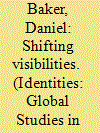| Srl | Item |
| 1 |
ID:
139517


|
|
|
|
|
| Summary/Abstract |
The New York-born journalist and travel writer Francis Nichols (1879-1904) is best known for his travels through early 20th-century China. However, his attempt in 1903-4 to travel through Tibet to Lhasa ahead of the Younghusband Mission, and thus to become the first westerner to reach the city, has been forgotten, partly on account of his death in the field and the loss of his diary. From new research in recently-catalogued documents and letters in the archives of the American Geographical Society (AGS), the author has compiled an account of Nichols’ mission to Lhasa, including the support he received from US backers, including the AGS, his travels in China, Tibet and India, and his relations with Younghusband and the British. Although Nichols was unable to reach Lhasa, the author observes that he should be credited as the first American to travel from India into the Chumbi valley in southern Tibet and across the Tibetan plateau from Phari to the town of Gyantse, 120 miles south-west of Lhasa.
|
|
|
|
|
|
|
|
|
|
|
|
|
|
|
|
| 2 |
ID:
157080


|
|
|
|
|
| Summary/Abstract |
This paper is a personal reflection by a Roma artist upon the mutual influence of Roma social relations and Roma visual culture. Strategies of art making are considered via analyses of contemporary Roma art works. It is suggested that historic marginalisation and continuing discrimination have determined the contingent nature of the Roma aesthetic resulting in keen facilities for adaptation and obscured visibility. Roma artefacts are shown to employ these resistant characteristics of Roma visuality to convey social, cultural, artistic and political agency via visual and performative means. The conclusion calls for a reconceptualisation of Roma visibilities so that we as Roma might forge new political unities and new forms of politics to more effectively challenge embedded Romaphobia.
|
|
|
|
|
|
|
|
|
|
|
|
|
|
|
|